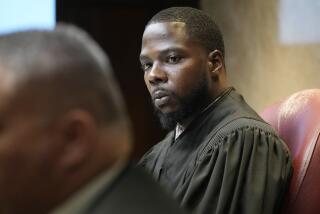Suspected Tucson gunman can be forced to take antipsychotic drugs, judge rules
- Share via
Reporting from San Diego — Accused Tucson gunman Jared Lee Loughner can be forced to take antipsychotic drugs while doctors attempt to make him fit to stand trial in the shooting of Rep. Gabrielle Giffords and 18 others, a federal judge ruled Wednesday.
Loughner, 22, is accused of killing six and wounding 13 during a Jan. 8 rampage as Giffords was greeting constituents. The Arizona Democrat was shot in the head but survived.
“I defer to medical doctors,” U.S. District Judge Larry A. Burns said at an emergency hearing requested by the defense. “I have no reason to disagree with doctors. I didn’t go to medical school.”
Loughner faces 49 felony charges, including murder and attempted murder, and could face the death penalty. He has pleaded not guilty. He has been diagnosed with schizophrenia and declared mentally incompetent to stand trial, at least for now.
His lawyers asked Burns to block doctors from medicating him without his consent. But the key question, the judge said, is whether Loughner is dangerous. Burns refused to second-guess physicians and noted that he had not issued any orders about Loughner’s need for medication.
Burns has twice rejected defense requests that Loughner’s attorneys be notified before he is given antipsychotic drugs.
Reuben Cahn, one of Loughner’s attorneys, said his client “has a right not to be medicated.” Doctors have been forcibly giving Loughner the medication since June 21, Cahn said. He urged that restraints or isolation be tried instead.
Loughner, who was not at the San Diego hearing, has been at a federal prison facility in Springfield, Mo., since late May, under the care of mental health specialists. Under federal rules, their task is to make him fit to stand trial and assist in his own defense. He is expected to spend four months there but could stay longer if his condition does not improve enough for trial.
In court filings, prosecutors detailed Loughner’s outbursts while incarcerated: spitting at his lead attorney, Judy Clarke; cursing and throwing a chair at a psychiatrist; and throwing a wet roll of toilet paper at a camera.
Assistant U.S. Atty. Wallace Kleindienst, on a video feed from Tucson, told Burns that Loughner was dangerous to other inmates and staff.
“This is a person who is a ticking time bomb,” he said.
A prison administrative hearing about whether Loughner should be given medication was held in Springfield two weeks ago. He refused to attend, prosecutors said. At that hearing, he was found to be dangerous.
Loughner’s attorneys have yet to say whether they will offer an insanity defense if the case goes to trial.
Wednesday’s hearing was in San Diego because Burns is based there. He was selected to try the case after all federal judges in Arizona recused themselves because the state’s chief federal judge, John Roll, was killed in the attack. A 9-year-old girl also was among the dead.
Giffords, 41, was discharged from TIRR Memorial Hermann Hospital in Houston on June 15 and is receiving outpatient therapy. She spent five months there while her husband, astronaut Mark E. Kelly, was training for the recently concluded Endeavour space shuttle mission. She traveled to Florida to watch the shuttle’s launch but did not appear in public.
The congresswoman’s recovery has been remarkable, but she still faces steep obstacles. Her chief of staff, Pia Carusone, told the Arizona Republic this month that Giffords had trouble speaking in sentences and often communicated through pointing, gesturing and facial expressions.
Giffords made her first public appearance since the shooting this week, at a ceremony honoring her husband and other astronauts. She received a standing ovation.
Special correspondent Neal Putnam contributed to this report.
More to Read
Sign up for Essential California
The most important California stories and recommendations in your inbox every morning.
You may occasionally receive promotional content from the Los Angeles Times.













